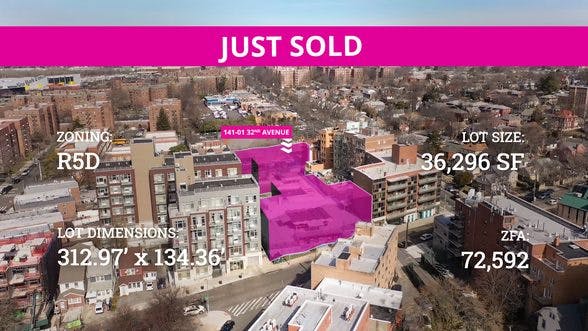The Rubin Report - The Pulse of the NYC Development / Issue No. 8 - August 2023
Rubin Isak
421-a Alternative: Executive Order for Gowanus, Brooklyn
Governor Kathy Hochul introduced a program targeting specific benefits and housing obligations similar to the former 421-a program in Gowanus, Brooklyn. Under this initiative, development proposals currently vested in the expired program can apply through Empire State Development.
The State would then purchase the privately owned properties for a nominal fee, leasing it back to the original owners for a long-term period matching the 421-a benefit duration. At the end of this period, the properties would be deeded back to the owners. In return, property owners must make payments equivalent to the reduced taxes they would have paid if construction had been completed before the program's expiration on June 15, 2026.
Highlighted Development Site Sale:

JUST SOLD:
141-01 32nd Avenue in North Flushing for $16,000,000 in an all-cash transaction. DSA® was the exclusive and sole broker in this transaction.
The sellers, The North Flushing Pool Club, have owned and operated the property as a swimming pool club for 63 years. (With over 270 owners!)
Construction Cost Trends
I recently sat in for a Gordian presentation on construction costs. Below are my takeaways, and I trust you will find it informative:
Summary of Construction Cost Trends:
1. Cost of Capital: Banks have tightened lending for construction and land development projects. To counter this, consider seeking alternative funding sources like private capital and private equity.
2. Cost of Labor: There is a scarcity of skilled workers, leading to increased risk in hiring. Preassembled materials could help mitigate this issue. Additionally, wages have risen by 5.4%. The industry is facing a challenge with experienced workers retiring, making labor the primary concern in construction.
3. Material Costs: Material costs have decreased by 4% to 6% as the global supply chain recovered from the pandemic's impact. Prices of goods from China have also dropped. Material supply deliveries have improved, but labor shortages and higher wages now pose a bigger challenge than material costs. Specific material trends include:
- Lumber prices are trending downwards and expected to return to pre-pandemic levels by Q3 2023.
- Steel prices have regressed by 25% from the previous year.
- Concrete & Masonry prices have also regressed.
- Electrical Metal Tubing and Copper prices show signs of stabilization and drop in pricing.
- Insulation costs are higher by 20% due to increased mineral wool pricing.
4. Equipment Rental Costs: Rental rates for construction equipment show volatility, with
some equipment costs decreasing (e.g., wheel loaders) while others increase (e.g., crane trucks rental rates, up by 16%).
5. Labor Costs: Labor rates have significantly increased, with wages rising by 21% to 40% across 23 trades. The construction industry faces challenges due to both labor shortages and the upcoming retirement of 25% of skilled workers next year. Consequently, labor costs have risen, and the overall quality of labor has declined.
US Inflation Rate Snapshot
The United States Inflation Rate has just increased to 3.18% from 2.97% last month; the first increase after 13 straight monthly declines.
The Fed's stated goal is to bring the rate to 2%. They just raised the rate on their July 27th meeting another 0.25% to 5.5%. I foresee another 0.25% rate increase in September.
A look at this inflation rate decline over the past year vs the 10-year:
US Inflation Rate vs. 10-Year US Treasury Rate:
June 30, 2022: Inflation Rate: 9.06% | 10-Year US Treasury: 2.98%
July 31, 2022: Inflation Rate: 8.52% | 10-Year US Treasury: 2.68%
August 31, 2022: Inflation Rate: 8.26% | 10-Year US Treasury: 3.15%
September 30, 2022: Inflation Rate: 8.20% | 10-Year US Treasury: 3.83%
October 31, 2022: Inflation Rate: 7.75% | 10-Year US Treasury: 4.10%
November 30, 2022: Inflation Rate: 7.11% | 10-Year US Treasury: 3.68%
December 31, 2022: Inflation Rate: 6.45% | 10-Year US Treasury: 3.88%
January 31, 2023: Inflation Rate: 6.41% | 10-Year US Treasury: 3.52%
February 28, 2023: Inflation Rate: 6.04% | 10-Year US Treasury: 3.92%
March 31, 2023: Inflation Rate: 4.98% | 10-Year US Treasury: 3.48%
April 30, 2023: Inflation Rate: 4.93% | 10-Year US Treasury: 3.44%
May 31, 2023: Inflation Rate: 4.05% | 10-Year US Treasury: 3.64%
June 30, 2023: Inflation Rate: 2.97% | 10-Year US Treasury: 3.81%
July 30, 2023: Inflation Rate: 3.18% | 10-Year US Treasury: 4.01%
A 3-year lookback:
On June 30, 2021 the US inflation rate was 5.39% | the 10-Year US Treasury Rate was 1.45%
On June 30, 2020 the US inflation rate was 0.65% | the 10-Year US Treasury Rate was 0.66%
On June 30, 2019 the US inflation rate was 1.65% | the 10-Year US Treasury Rate was 2.01%
Financial Markets Summary
- The Federal Prime Rate is now up to 8.5%.
- The Secured Overnight Financing Rate (SOFR) is now at 5.31% it’s highest level ever.
- The United Stated Federal Funds Rate has risen to 5.5%
- United States Annual Inflation Rate: The current inflation rate is now at 3.18%, up from 2.97% from the previous reading. The Fed’s stated goal is to steadily raise rates until they are able to achieve a 2% inflation rate.
- The US 1-Year Treasury Rate is now at 5.34%.
- The US 10-Year Treasury Rate is now up to 4.01%.
- Mortgage Rates: the average 30-Year Fixed Rate is now 7.05% and the 15-Year Fixed Rate is 6.42%.

